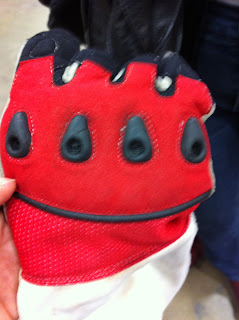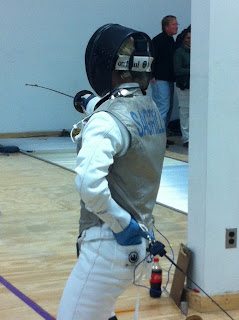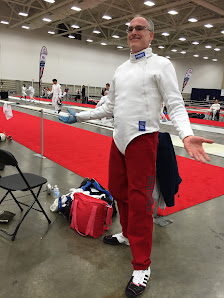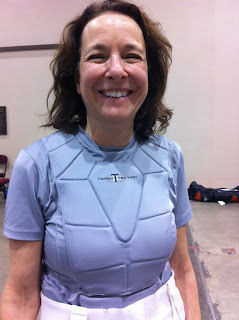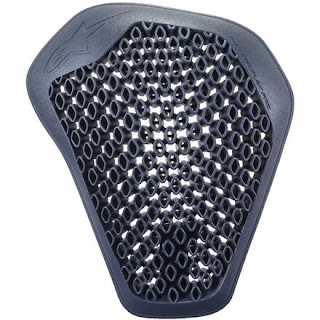- The easiest jackets to sew onto are the lightest of LP and Allstarr Startex. The harder, thicker ones are Negrini and PBT to get the needle through. I use quilting needles.
- I make an accurate pattern using the jacket onto sewing pattern paper, cut out neoprene of the desired thickness using the pattern, wrap white athletic mesh around the neoprene, sew the mesh onto the neoprene and sew the mesh onto the jacket. Don't use anything other than athletic mesh because they will break or absorb sweat to increase weight. Cotton or silk do not work well. Get a yard or two of the white mesh online or at a local sewing store.
- The best way to get neoprene is to buy waist protectors/ lifting belts and sweat belts at sports stores or Amazon. They differ by thickness and McDavid works for me. Look for the ones that don't have material or hardware on them. Cut off the piece that has the rough velcro.
- I've tried other materials than neoprene, including the expensive shin protector materials that LP sells but nothing is better than neoprene.
- Of course, you could use a sewing machine for the chest/ shoulder, but the arms require hand stitching. I know because I took it to a fencing mom who's a professional seamstress once and it cost over $375 for all the hand sewing so I sew it myself now and it looks almost professional.
- A well sewn neoprene piece will last as long as the jacket and I've had mine for 10+ years. You'll just need to reinforce where the mesh attaches to the jacket but nothing has ever ripped before.
- I'd recommend putting the work into a new quality jacket because it takes me 30+ hours to sew on all the pieces but if you're aiming to sew on just one or two where the guys are battering you, it'll be an afternoon project.
- For the collarbone and chest above the plastic protector and right bicep where we get hit often, I'd recommend 2 layers of neoprene wrapped into the mesh. For other places I'd recommend only 1 layer to not inhibit your flexibility, especially during infighting.
- I have pieces around the chest/ collarbone, right bicep, inner left bicep, left hand watch/ wrist/ right shoulder for flicks, right thigh and hip bone.
- For my knees and shine, I wear very loose compression braces made of neoprene. A 25 year old guy did a horizontal coupe missing my lame entirely, landing on my shin and breaking it two years ago. My coach got hit so hard on the hip bone every night at practice when he was on the national team his bone died and is permanently numb so definitely worth it to protect whatever parts you wanna keep.
- When you sew, stitch close to the stitch line to minimize thread appearance. Take larger 0.5-1cm stitches on the inside and take tiny, barely visible stitches on the outside. Use safety pins to secure the piece before sewing. After you've sewed a piece onto the jacket or pants where it holds up, try it on in the on guard stance, move a little to make sure the piece covers exactly how much of your body you want to protect.
- Use a synthetic thread, if you have a synthetic jacket. Do not use cotton thread, even if it's very thick because they don't last. I use Coats & Clark eloflex double threaded.
- Last month a blade bounced off my chest protector and broke a bone in my left hand so now I wrap it.
- The guys have given me bone bruises around the ankle that have shown up on x-rays so I put either a piece of neoprene or cut out of a foam shoe insert underneath my socks around the front ankle for their 7 and 8 parries/ searches."
Documenting the sartorial exploits of fencers with flair, in practice, in competition and on the podium.
Sunday, April 17, 2022
Vet Armor Part 2: Taking it to the Max
Saturday, April 2, 2022
Vet Armor Part 1
The other Sunday, at RFA's Vet ladies' practice, we were trading notes on minor injuries. Emergent themes: how to assure the doctor/nurse they don't need to call protective services; how to tell a skin bruise from a bone bruise (ick); and (as a logical segue) various ways to reinforce or supplement one's gear to avoid the prior issues.
Joe's knickers (rated 350N) were manufactured by Triplette. I can see where a layer of competition-grade padding over the sock would help at least a bit.
Turns out there are a lot of potentially useful padded undergirding manufactured for other sports. See, for example "Nike Contact Support Forearm Shivers"
After getting popped right on the head of the shoulder joint recently, with two weeks of resulting soreness, this might the extra piece of armor I try next.
Saturday, January 15, 2022
Looking Back to Look Forward
Hello Ladies
It was so great to see some of you in San Jose last week. Your smizing eyes, your laughter, and your camaraderie was a balm to my pandemic-weary heart.
 |
| Marie Lawson at the July 2021 NAC/National Challenge |
Between the masking, distancing, and the fact that many folks spent as little time as possible in the venue, I did not get any new pics for Fashionista. So today's posts is a nostalgic look at some of my most-beloved images from the past.
One of my all-time favorite outfits is Pam Guntrum rocking color-matched boa and head scarf at the 2018 Portland NAC, patriotically complemented with a red water bottle and foil tape.
 |
| Pamela Guntrum, 2018 Portland NAC |
Looking back over my files, I realize I have far more photos of vet women heading into or out of the venue, since I'm usually preoccupied with, you know, ACTUALLY FENCING on the days of my events. Fortunately, you are genius at accessorizing.
 |
 |
| With my teammate Gemin Channing at the Utah Museum of Fine Art, Salt Lake City NAC, December 2019 |
 |
| With Pam Dressel, center, and Anne-Marie Walters at Al Carbon in Rockville, MD |
 |
| With RFA coaches Katherine Guernsey (Tabby) and Liz Searles, née Blankenship (aka The Dormouse) |
Salute, and hugs









